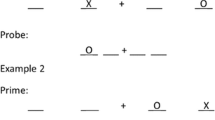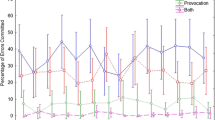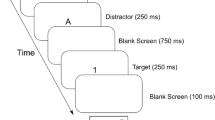Abstract
Responding to the location of a target is slower when it appears at a recent distractor location [ignored-repetition (IR) trial] than when it arises at a new position [control (CO) trial], defining the location negative priming (NP) effect. On IR trials, both the distractor location and response are from the prior trial, and the locus question asks whether the delayed responding that arises is caused by the reused distractor position (i.e., a location locus) or the need to execute a distractor output (i.e., a response locus). A location NP procedure was used, incorporating a many:1 location-to-response mapping design, along with a response cue on some trials. A response locus for the location NP effect was indicated. Distractor-turned-target responses took longer to initiate than new outputs (many:1 paradigm), and valid response cues reduced distractor response interference and the location NP effect. Importantly, a possible S-R compatibility problem within the many:1 S-R paradigm was not supported.

Similar content being viewed by others
Notes
While Tipper et al. (1990) have shown that the prime-trial distractor object itself would be inhibited, it is clear that object inhibition cannot be the locus or cause of the location NP effect, simply because the prime distractor object does not participate in ignored-repetition trials. Rather, on these occasions, the prime distractor object is replaced by the target stimulus object. Thus, any slowing seen on ignored-repetition trials cannot be the result of the re-appearance of the prime distractor object from one trial to the next.
While the predictable removal of the probe distractor eliminates the location NP effect when the prime trial contains both a target and a distractor (Buckolz et al., 2002a), it does not do so when distractor-only primes are used (not tested for identity tasks) [Guy et al., 2004; Milliken et al., 2000]. Hence, we were able to study the influence of valid response cues when the probe trial knowingly lacked a distractor event. We want to emphasize that probe distractor manipulations do not always influence location and identity NP effects in the same way (e.g., Buckolz et al., 2004a; Guy et al., 2004; Moore, 1994; Neill et al., 1994; Tipper et al., 1990) and so the findings here in this regard are intended to be applied only to the location NP process.
An anonymous reviewer raised the possibility that the need to process cue information between prime and probe trial deliveries, irrespective of its information content (i.e., uninformative vs. informative cues), might have had some unexpected impact on the normal operation of the NP process. Accordingly, we ran a location NP task where the cue event was removed but where the time delay between prime onset and probe offset approximated that used in the cue conditions (i.e., 2,000 ms). A significant location NP effect of 30 ms was obtained [RT(IR)= 504 ms (SD= 98) vs. RT(CO)= 474 ms (SD=85)], t(15)= 3.06, SDD= 39.00, P< 0.01, which compared favourably in size to the NP effect produced with the uninformative cue condition (36 ms, Table 2). These findings indicate that requiring cue processing that intervenes between prime and probe trials does not appear to influence the normal functioning of the location NP process, and also show that the NP process continues to function for at least 2000 ms. These findings are predictable from results reported by Tipper, Weaver, Cameron, Brehaut, and Bastedo (1991). They showed that processing that intervened between prime and probe trial presentations, which is unrelated to the NP task and which might include an overt response, does not influence the location NP process, and that this process continued to operate for about 6 seconds.
References
Baylis, G. C., Tipper. S. P., & Houghton, G. (1997). Externally cued and internallygenerated selection: Differences in distractor analysis and inhibition. Journal of Experimental Psychology: Human Perception and Performance, 23, 1617–1630.
Buckolz, E., & Rugins, O. (1981). Evidence of response bias facilitation on choice reaction time within a many:1 stimulus-response paradigm. Journal of Human Movement Studies, 5, 97–104.
Buckolz, E., Boulougouris, A., & Khan, M. (2002a). The influence of probe-trial selection requirements on the location negative priming effect. Canadian Journal of Experimental Psychology, 56, 274–283.
Buckolz, E., Boulougouris, A., O‘Donnell, C., & Pratt, J. (2002b). Disengaging the negative priming mechanism in location tasks. European Journal of Cognitive Psychology, 14, 207–225.
Buckolz, E., Goldfarb, A., & Khan, M. (2004). The use of a distractor-assigned response slows later responding in a location negative priming task. Perception & Psychophysics, 66, 837–845.
Buckolz, E., Guy, S., Khan, M., & Lawrence, G. (2005). Can the location negative priming process operate in a proactive manner. Psychological Research (on line).
Christie, J., & Klein, R. (2001). Negative priming for spatial location? Canadian Journal of Experimental Psychology, 55, 24–38.
De Jong, R., Liang, C-C., & Lauber, E. (1994) Conditional and unconditional automaticity: A dual-process model of effects of spatial stimulus-response correspondence. Journal of Experimental Psychology: Human Perception and Performance, 20, 731–750.
Eimer, M. (1995). Stimulus-response compatibility and automatic response activation: Evidence from psychophysiological studies. Journal of Experimental Psychology: Human Perception and Performance, 21, 837–854.
Eimer, M., Schubo, A., & Schlaghecken, F. (2002). Locus of inhibition in the masked priming of response alternatives. Journal of Motor Behavior, 34, 3–10.
Eriksen, C. W., Coles, M. G. H., Morris, L. R., & O’Hara, W. P. (1985). An electromyographic examination of response competition. Bulletin of the Psychonomic Society, 23, 165–168.
Fitts, P., & Seeger, C. M. (1953). SR compatibility: Spatial characteristics of stimulus and response codes. Journal of Experimental Psychology, 46, 199–210.
Geller, E. S. (1974). Preceding prediction outcome and prediction outcome probability: interacting determinants of choice reaction time. Journal of Experimental Psychology, 103, 426–430.
Geller, E. S. (1975). Prediction outcome and choice reaction time: inhibition versus facilitation effects. Acta Psychologica, 39, 69–82.
Grison, S., Tipper, S. P., & Hewitt, O. (2005). Long-term negative priming: support for a retrieval of prior attentional processes. Quarterly Journal of Experimental Psychology: Section A, (in press).
Guy, S., & Buckolz, E. (2004). Cueing the response in a location negative priming task: Locus implications. Presented to the North American Society for the Psychology of Sport and Physical Activity, Vancouver, British Columbia, Canada. (June)
Guy, S., Buckolz, E., & Pratt, J. (2004). The influence of distractor-only prime trials on the location negative priming mechanism. Experimental Psychology, 51, 1–11.
Guy, S., Buckolz, E. & Khan, M. (2005). The locus of location repetition latency effects. Manuscript under review.
Houghton, G., & Tipper, S. P. (1994). A model of inhibitory mechanisms in selective attention. In Inhibitory mechanisms in attention, memory, and language (ed. D. Dagenbach & T. Carr), pp. 53–112. Orlando, FL: Academic Press.
Keele, S. (1969). Repetition effect: A memory dependent process. Journal of Experimental Psychology, 80, 243–248.
Keele, S. W. (1973). Attention and human performance. Pacific Palisades, California: Goodyear.
Milliken, B., Tipper, S. P., Houghton, G., & Lupianez, J. (2000). Attending, ignoring, and repetition: On the relation between negative priming and inhibition of return. Perception & Psychophysics, 62, 1289–1296.
Neill, W. T., Terry, K. M., & Valdes, L. A. (1994). Negative priming without probe selection. Psychonomic Bulletin and Review, 1, 119–121.
Neill, W. T., Valdes, L. A., & Terry, K. M. (1995). Selective attention and the inhibitory control of cognition. In Frank M. Dempster & Charles J. Brainerd (Eds.), Interference and Inhibition in Cognition. Academic Press: New York (pp. 207–261).
Tipper, S. P. (1985). The negative priming effect: Inhibitory priming by ignored objects. Quarterly Journal of Experimental Psychology, 37(A), 571–590.
Tipper, S. P. (2001). Does negative priming reflect inhibitory mechanisms? A review and integration of conflicting views. The Quarterly Journal of Experimental Psychology, 54A, 321–343.
Tipper, S. P., & Cranston, M. (1985). Selective attention and priming: Inhibitory and facilitatory effects of ignore primes. Quarterly Journal of Experimental Psychology, 37A, 581–611.
Tipper, S. P., Brehaut, J. C., & Driver, J. (1990). Selection of moving and static objects for the control of spatially directed action. Journal of Experimental Psychology: Human Perception and Performance, 16, 492–504.
Tipper, S. W., Weaver, B., Cameron, S., Brehaut, J., & Bastedo, J. (1991). Inhibitory mechanisms of attention in identification and localization tasks: Time course and disruption. Journal of Experimental Psychology: Learning, Memory, and Cognition, 17, 681–692.
Valle-Inclan, F., & Redondo, M. (1998). On the automaticity of ipsilateral response activation in the Simon effect. Psychophysiology, 35, 366–371.
Whitman, C. P. & Geller, E. S. (1974). Prediction outcome probabilities as determinants of choice reaction time. Perception & Psychophysics, 13, 105–109.
Author information
Authors and Affiliations
Corresponding author
Additional information
This research was supported by a scholarship awarded to SG and an operating grant to EB, both from the Natural Sciences and Engineering Research Council of Canada. We are indebted to Ioan Todoran for programming.
Rights and permissions
About this article
Cite this article
Guy, S., Buckolz, E. The locus and modulation of the location negative priming effect. Psychological Research 71, 178–191 (2007). https://doi.org/10.1007/s00426-005-0003-9
Received:
Accepted:
Published:
Issue Date:
DOI: https://doi.org/10.1007/s00426-005-0003-9




